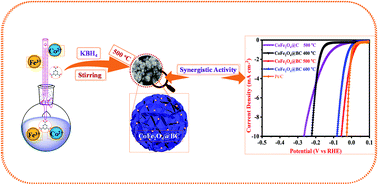Hierarchical ultrathin defect-rich CoFe2O4@BC nanoflowers synthesized via a temperature-regulated strategy with outstanding hydrogen evolution reaction activity†
Abstract
Designing simplistic, efficient, durable, and highly eco-friendly electrocatalysts toward the hydrogen evolution reaction is essential for large-scale and economical practical applications. In this work, the as-fabricated CoFe2O4@boron-doped carbon (CoFe2O4@BC) nanoflowers consisted of nanosheets with a porous structure and plenty of enriched catalytic sites. The remarkable electrocatalytic activity of the as-fabricated nanomaterial offers a worthwhile approach to improve the performance and stability of transition metal-boride electrocatalysts. Therefore, the as-synthesized CoFe2O4@BC 500 °C electrocatalyst displays a low geometrical overpotential of 58 mV at 10 mA cm−2 for the HER with a small Tafel slope of 50 mV dec−1 and long-term stability of 100 h in 1.0 M KOH solution. Ultimately, the outstanding CoFe2O4@BC 500 °C nanoflower displays significantly enhanced HER activity, which could be mainly attributed to the following factors: (i) unique flower-like nanoarchitecture fabrication, (ii) the exposure of plentiful active sites in the architecture of the CoFe2O4@BC 500 °C nanoflowers, (iii) electrical conductivity of the catalyst driven by the doping of boron, (iv) numerous defects in the porous structures of the nanoflowers and abundant electron delocalization, and (v) the synergistic co-existence of Co and Fe metals and boron, which promotes the electrochemical performance. Therefore, this work provides a unique strategic plan for the design of efficient and stable B-doped electrocatalysts in an alkaline solution.



 Please wait while we load your content...
Please wait while we load your content...